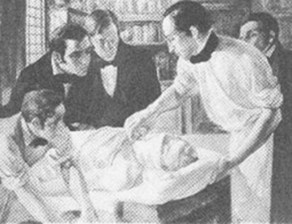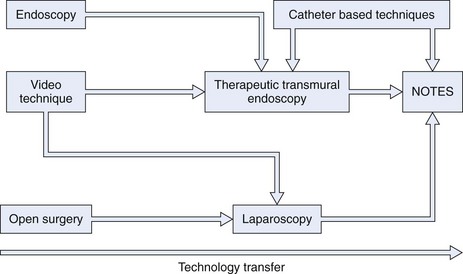Chapter 55 Surgical Perspectives on Natural Orifice Transluminal Endoscopic Surgery (NOTES)
Introduction
Surgical procedures have been performed since Neolithic times with advances in the field marked by key events.1 In 1809, McDowell completed the first successful abdominal operation without the use of general anesthetic.2 The invention and use of inhaled ether as a form of general anesthetic marks the first great advance in surgical therapy (Fig. 55.1), followed by the introduction of antisepsis by Lister.3 In the centuries that followed, large abdominal incisions were required to permit the surgeon’s hands and instruments access to the disease process. More recently, disease processes have been accessed with smaller incisions (as in laparoscopy) or by a different route entirely (endoscopy or endovascular), decreasing the pain and infection risk of the abdominal incision and improving patient outcomes.
Natural orifice transluminal endoscopic surgery (NOTES) is an experimental surgical technique whereby scarless abdominal operations can be performed with an endoscope passed through a natural orifice (mouth, anus, vagina, or urethra) and then through an internal incision in the stomach, colon, posterior vaginal fornix, or bladder, avoiding any external incisions or scars (Fig. 55.2). Similar to the introduction of laparoscopy, surgical opinions of this new approach vary widely. This chapter briefly reviews NOTES and examines current surgical opinions.
History of Minimally Invasive Surgery
The advent of minimally invasive surgery brought with it an opportunity to decrease postoperative pain with resultant shorter hospital stays and quicker returns to normal activity and to shrink surgical scars, providing a more pleasing cosmetic outcome.4 The minimally invasive surgery concept influenced the next paradigm shift in intervention, NOTES, which may eliminate the anterior abdominal wall approach altogether (Fig. 55.3).
History of Natural Orifice Transluminal Endoscopic Surgery
The history of NOTES begins in 1901, when Ott performed the first endoscopic examination of the peritoneal cavity through the vagina.5 He termed the procedure ventroscopy and became the pioneer of natural orifice access. The feasibility of a peroral transgastric flexible endoscopic approach to the peritoneal cavity with long-term survival in a porcine model was reported by the Apollo Group in 2004 (Fig. 55.4).4
Stay updated, free articles. Join our Telegram channel

Full access? Get Clinical Tree










